Please Use the Additionally Released “Marugoto Can-do (B1)” for Creating a Task-Based Class!
- Nihongo Kyoiku News
- This corner introduces the latest information on matters of high interest to overseas Japanese-language educators from among the Japanese-Language Education Programs conducted by the Japan Foundation.
April, 2024
The Japan Foundation Japanese-Language Institute, Urawa
New B1-level JF Can-dos were added to the Can-do database of the “Minna no Can-do website” in May 2023. The “Minna no Can-do website” has both CEFR Note 1 Can-dos and JF Can-dos Note 2. The newly added JF Can-dos are exceedingly useful, allowing users to confirm specific conversations, tasks, and more in MARUGOTO: Japanese Language and Culture (hereinafter “Marugoto”), and are known as “Marugoto Can-do.” This article introduces the features of these Marugoto Can-dos and how to use them.
What are Marugoto Can-dos?
Marugoto Can-dos are JF Can-dos that correspond to the learning objectives of each Lesson in Marugoto, a coursebook series based on the JF Standard for Japanese-Language Education. The 52 newly added Marugoto Can-dos Note 3 are for the Marugoto Intermediate 1 and 2 (B1 level). Marugoto Can-dos include information on the corresponding learning objectives, so users can gain a concrete understanding of the language activity set out in the Can-do by looking at that Marugoto activity (Image 1).
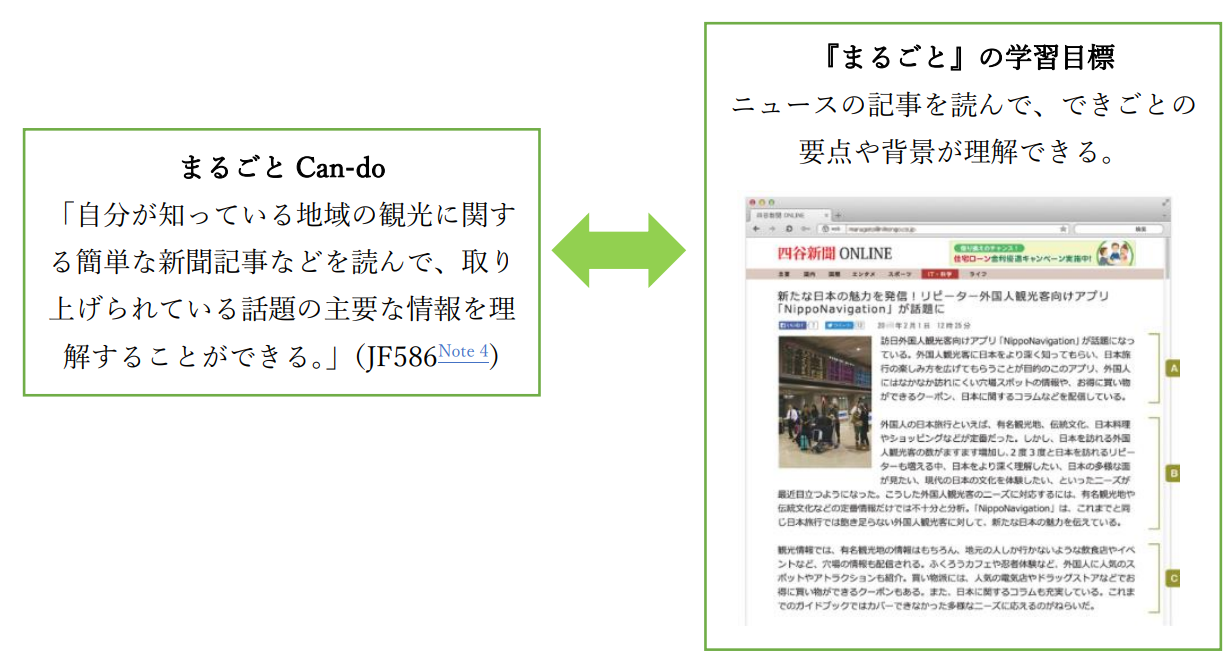
Image 1: Example of a Marugoto Can-do and the corresponding learning objective and activity
What is B1 level?
At A2 level, learners need the help of their conversation partner, who might speak slowly and clearly and/or repeat themselves when communicating, but learners at B1 level can handle most situations that happen in regular, everyday life on their own Note 5. Their conversation partners and the scope of their conversations will grow, and what they can do in everyday life in society will increase. For example, they will become able to respond to issues that arise during everyday life or while traveling, offer somewhat detailed explanations about their interests, and read coherent texts, such as newspaper articles.
The newly added Marugoto Can-dos cover a wide range of language activities that learners might encounter in everyday life, such as sending a complaint email requesting to return an item bought online in the case that the item is broken (Image 2), talking about reasons for liking a favorite artist and the artist’s appeal (Image 3), and understanding the key points of an event when watching the news on TV (Image 4).
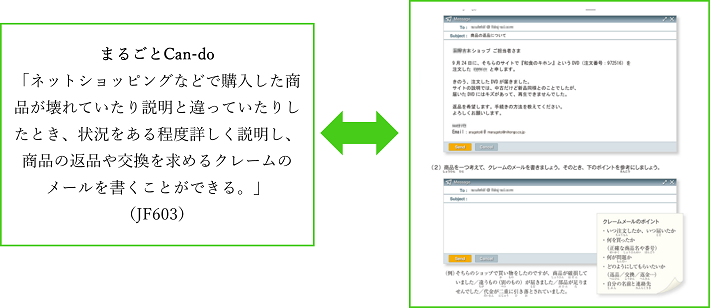
Image 2: Email writing activity

Image 3: Speaking activity

Image 4: Listening activity
Where can you access the Marugoto Can-dos?
You can search for the Marugoto Can-dos on the “Minna no Can-do website” (Image 5).
First, on the “Can-do search” page, select (1) JF and (2) B1 in the “Type” section, then select (3) “JF Marugoto” under “Can-dos with Examples.” This will display all the B1 Marugoto Can-dos. If you are hoping for a more specific language activity setting or content, you can narrow this down using (4) “Topic” and (5) “Category” Note 6.
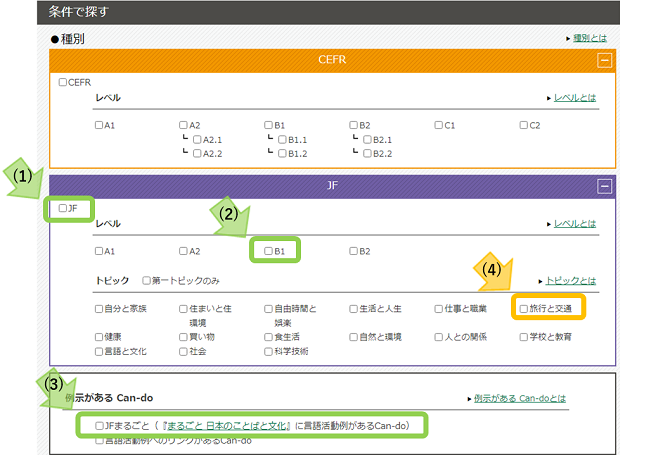
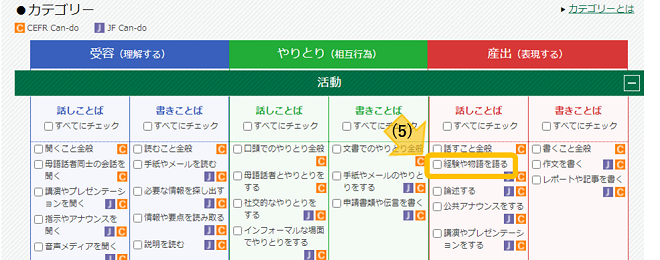
Image 5: Can-do website search screen
This search used “Travel and transport” as the topic and “Sustained monologue: describing experience” as the category, based on the idea of an activity that involves learners talking about something they have experienced or know about. The Can-do pictured in Image 6 is one of the Marugoto Can-dos displayed by this search. You can look at (6), the “Reference information” column on the far right, to find the learning objective and Marugoto Lesson to which the Can-do corresponds.

Image 6: Example of a Marugoto Can-do
“Can explain to a colleague who has come to work in one’s country how to use public transport and what to be careful of in some detail.” (JF559)
Recommended uses for Marugoto Can-dos!
Next, this section introduces ways of using the Marugoto Can-dos Note 7. The Marugoto Can-dos are very useful when you are considering task-based lessons Note 8, because they reference specific activities in Marugoto. Task-based lessons are classes that emphasize whether a learner is able to use Japanese to do something in an actual social situation.
- Understand the B1 task completion level
The B1 Can-dos often use phrases such as “of some length/in some detail” and “coherently/well-organized,” but it might be difficult to imagine what length of text this should actually be or what kind of conversation structure is expected just from reading the Can-dos. If you look at the specific texts, tasks, and model conversations in Marugoto, you can confirm your idea of the B1 level and examples of reaching the goals. - You can see examples of classroom activities
The Marugoto Can-dos are particularly useful when you want examples of lessons, class activities, or teaching materials that use the Can-dos as learning objectives. Image 7 shows the Marugoto activities that correspond to the Can-do “Can explain to a colleague who has come to work in one’s country how to use public transport and what to be careful of in some detail.” First, (1) learners listen to the model conversation and confirm the vocabulary and expressions. Then, (2) they organize the main points of the model conversation, such as how to buy a ticket and how to use the line, and practice speaking with consideration for the composition. Finally, (3) learners make notes and talk about public transport in their own country. Using the flow of the Marugoto activities and specific tasks as a reference, instructors can create lessons and obtain hints for classroom activities.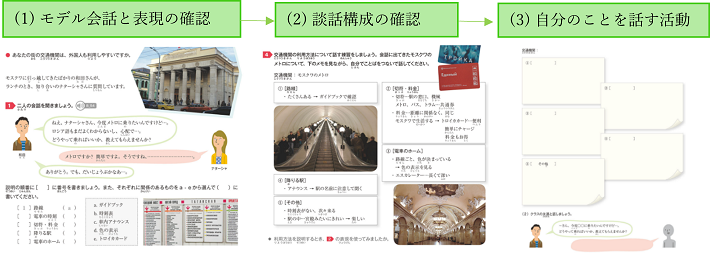
Image 7: Example of Marugoto activities
- You can create Can-dos as learning objectives that suit your own learners
This section also introduces practical assessments. The features of the Marugoto Can-dos mean that they specify conversation partners, settings, and what to talk about. As the structure of the Can-do sentences are easy to understand, you can create your own Can-dos (MY Can-dos Note 9) that meet your learners’ needs and aims, based on the Marugoto Can-dos. For example, using the Marugoto Can-do topic “Travel and transport” mentioned earlier, you could rewrite the can-do for learners in schools overseas: “Can explain to a Japanese teacher who has come to work in one’s school how to use the library and what to be careful of in some detail,” or for learners who are working in Japan: “Can explain to a new employee who has come to one’s workplace how to use office equipment such as the photocopier and printer and what to be careful of in some detail.” Replacing the context with a situation that is familiar to the learner and using this as a learning objective can increase their communicative competence in a real-life setting.
Make use of the JF Can-dos!
It has been around two decades since the publication of the CEFR, and 12 years since the announcement of the JF Standard for Japanese-Language Education. Recently, the Agency for Cultural Affairs has also released the 「日本語教育の参照枠(報告)」, meaning there are more and more opportunities to consider task-based lessons. Try constructing Japanese language lessons using the Marugoto Can-dos as learning objectives. We hope you will make use of the “Minna no Can-do website” and the JF Can-dos from now on!
- Notes:
-
- 1.CEFR is the acronym for the Common European Framework of Reference for Languages: Learning, teaching, assessment. It was announced by the Council of Europe in 2001 as a shared framework for language education and learning sites in Europe, and is used for various global languages in Europe and elsewhere.
- 2.These Can-dos offer examples of communicative language activities in Japanese, and were created independently by the Japan Foundation with reference to the CEFR. They illustrate specific and realistic scenarios and situations based on 15 topics. You can make use of 493 CEFR Can-dos (levels A1 to C2) and 604 JF Can-dos (levels A1 to B2) on the “Minna no Can-do website.”
- 3.In addition to the 52 new Marugoto Can-dos, Marugoto Intermediate 1 and 2 information has been added to 25 existing JF Can-dos.
- 4.On the Can-do website, each JF Can-do has a number, displayed as “JF●●● (number).” When searching by keyword on the Can-do website, you can search by entering the JF number.
- 5.You can get an overall image of the six levels in “CEFR Common Reference Levels: global scale” 【PDF: 422KB】.
- 6.The categories can be broadly divided into “reception, production, and interaction (spoken/written),” and express the characteristics of the language activity.
- 7.You can also refer to a past article for information on how to make use of the Marugoto Can-dos: 「みんなのCan-doサイト」に“まるごとCan-do”が追加されました!
- 8.See the “JF Standard for Japanese-Language Education and Can-dos” for a more detailed explanation.
- 9.See the JF Standard for Japanese-Language Education Guidebook for Users [New Edition] for more detailed information on the process of MY Can-do creation.
(IKEDA Kanako and ITO Yukiko, Japanese-Language Education Specialist, Japanese-Language Institute, Urawa)
- What We Do Top
- Arts and Cultural Exchange [Culture]
- Japanese-Language Education Overseas [Language]
- Japanese-Language Education Overseas [Language] Top
- Learn Japanese-language
- Teach Japanese-language
- Take Japanese-Language Test
- Know about Japanese-language education abroad
- The Japanese-Language Institute, Urawa
- The Japanese-Language Institute, Kansai
- Japanese-Language Programs for Foreign Specified Skilled Worker Candidates
- Japanese Language Education for Japanese Children Resident Overseas and for the Descendants of Migrants
- Archives
- Japanese Studies and Global Partnerships [Dialogue]
- JF digital collection
- Other Programs / Programs to Commemorate Exchange Year
- Awards and Prizes
- Publications
